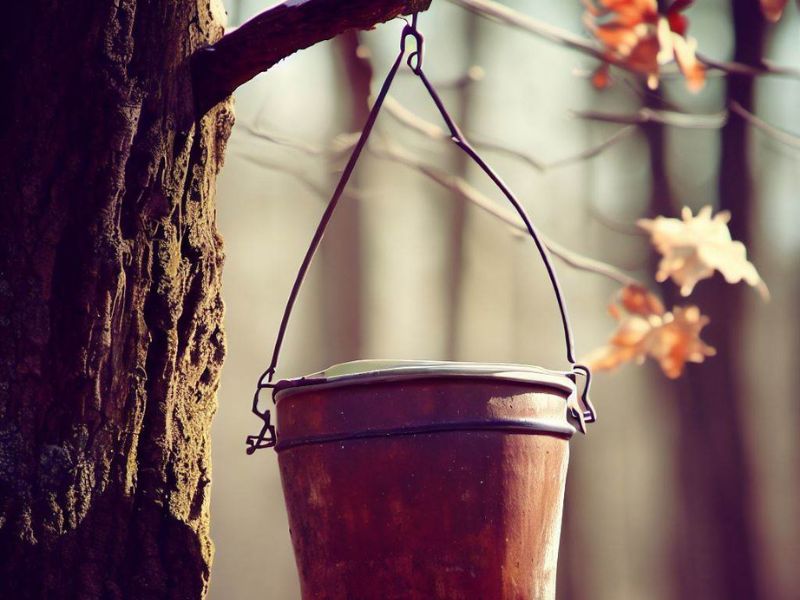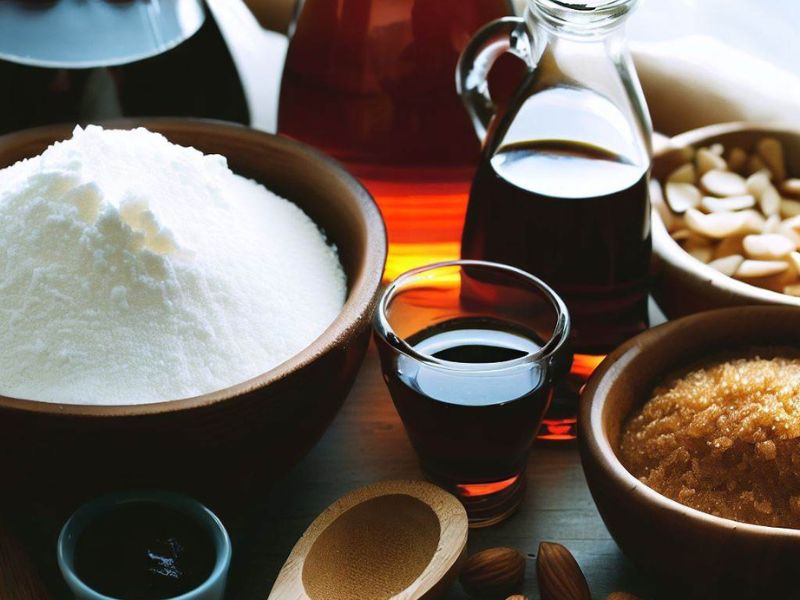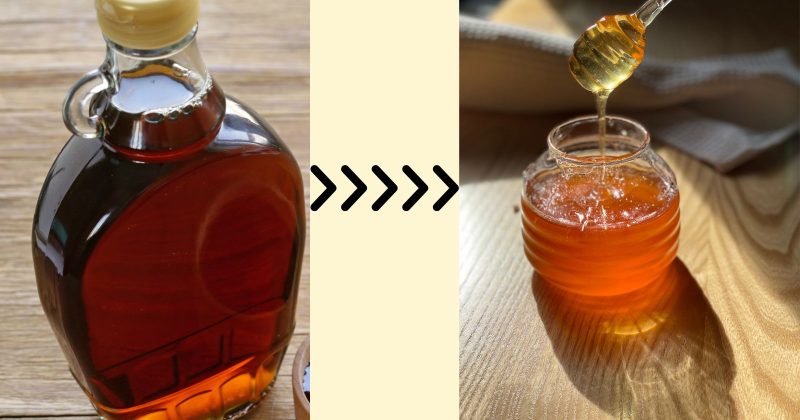In the world of natural sweeteners, two names often stand out: honey and maple syrup. Both have been cherished for their unique flavors and versatility in recipes. But a common question arises: “Can I substitute maple syrup for honey?” The answer is yes, you can! While each has its distinct taste and characteristics, they can often be interchanged in recipes with a few adjustments.
Understanding Honey

Honey, often referred to as nature’s liquid gold, has been a cherished sweetener for millennia. Its journey from flower nectar to our kitchen shelves is a fascinating tale of nature and nurture.
How Do We Get Honey from Bees to Bottles?
Honey starts its life as flower nectar. Worker bees collect this nectar and store it in their honey stomachs. Once back at the hive, they pass it onto housebees through regurgitation. These bees then process the nectar by evaporating its water content and adding enzymes, transforming it into honey. This honey is stored in honeycomb cells, which are sealed with beeswax once full. Beekeepers collect these frames, extract the honey, filter out impurities, and bottle it for our use.
What Makes Honey’s Flavor So Unique?
The flavor of honey is influenced by the types of flowers the bees visit. For instance:
- Clover Honey: Light and mildly sweet, it’s one of the most common types.
- Manuka Honey: Native to New Zealand, it has a stronger, earthy flavor and is renowned for its health benefits.
- Buckwheat Honey: Darker and richer, it’s almost molasses-like in taste.
Besides the floral source, factors like soil quality, climate, and even the type of bees can influence honey’s flavor.
How Does Honey Behave in Baking?
Honey isn’t just a sweetener; it’s a multifunctional ingredient in baking.
- Moisture: Honey is hygroscopic, meaning it attracts moisture. This property can make baked goods moister and extend their shelf life.
- Sweetness: It’s sweeter than sugar, so you might need less of it in recipes.
- Browning: Honey caramelizes at a lower temperature than sugar, leading to a darker, more golden crust on baked goods.
- Acidity: Honey is naturally acidic, which can react with baking soda in recipes to help baked goods rise.
What Secrets Does Maple Syrup Hold?

Maple syrup is more than just a sweet topping for pancakes and waffles. Its rich history, intricate production process, and unique flavor profile make it a fascinating subject, especially for those who love to bake.
From Tree to Table
The journey of maple syrup starts in the sugar maple trees, predominantly found in the northeastern regions of North America. During the cold nights and warmer days of late winter and early spring, these trees produce sap.
- Collection: Using taps inserted into the trees, the clear and almost tasteless sap is collected. Traditional methods involved hanging buckets, but modern practices use a system of tubes for more efficient collection.
- Boiling: The collected sap is then boiled. As the water in the sap evaporates, what remains is the thick, sweet syrup we’re familiar with. It takes about 40 gallons of sap to produce just one gallon of maple syrup!
- Grading: Not all maple syrups are the same. They’re graded based on their color and flavor. The lighter the syrup, the higher its grade and the milder its flavor. Darker syrups, often used for baking, have a robust flavor.
Flavor
Maple syrup is celebrated for its unique flavor, which is more than just plain sweetness.
- Earthy and Woodsy: The primary notes of maple syrup are reminiscent of the forests where the sugar maples grow. There’s a deep, earthy undertone to its sweetness.
- Hints of Caramel and Vanilla: As the sap is boiled down, caramelization occurs, adding a layer of complexity to its taste. Some even detect a hint of vanilla, especially in the higher-grade syrups.
- Variations: Just as with wine, the flavor of maple syrup can vary based on where it’s produced. The soil, climate, and specific tree variety all play a role in its final taste.
Maple Syrup in Baking

Maple syrup isn’t just for drizzling over breakfast dishes. In baking, it’s a versatile ingredient that can elevate a recipe.
- Sweetness: Maple syrup is less sweet than granulated sugar. When substituting in recipes, you might need to adjust quantities to achieve the desired sweetness level.
- Moisture and Texture: Being a liquid, maple syrup can add moisture to baked goods. This is excellent for recipes where a soft, moist outcome is desired, like muffins or certain cakes.
- Caramelization: Maple syrup caramelizes beautifully at high temperatures, giving baked goods a delightful golden-brown hue.
- Pairings: Its unique flavor pairs well with certain ingredients like nuts (especially walnuts and pecans), apples, and spices like cinnamon and nutmeg.
Substituting Maple Syrup for Honey
| 🍯🍁 Maple Syrup vs. Honey: The Sweet Swap Guide 🍁🍯 | |
|---|---|
| Sweetness Level | Maple syrup is slightly less sweet than honey. |
| Texture | Maple syrup is thinner, while honey is thicker and more viscous. |
| Flavor Profile | Honey has floral notes, while maple syrup has a caramel-like, earthy flavor. |
| Best Used In | Honey is great for teas and light pastries. Maple syrup shines in pancakes and waffles. |
| Substitution Ratio | Generally, a 1:1 ratio works, but adjustments might be needed based on the recipe. |
| 🍰 Brought to You by wearebaking.com 🍰 | |
Swapping one ingredient for another in baking isn’t always straightforward. When considering replacing honey with maple syrup, there are several factors to consider, from flavor to the chemistry of baking.
Conversion Ratios
While both honey and maple syrup are liquid sweeteners, their sweetness levels and consistencies differ slightly.
- Basic Ratio: For most recipes, a 1:1 substitution works. This means if a recipe calls for 1 cup of honey, you can use 1 cup of maple syrup.
- Recipe Adjustments: Depending on the specific dish, you might need to make minor adjustments. For instance, because maple syrup is slightly less viscous than honey, you might need to reduce other liquids in the recipe by a small amount to maintain the desired consistency.
Taste and Texture Changes
Swapping honey for maple syrup will bring about changes in both flavor and texture.
- Flavor Shift: Honey’s floral and sometimes buttery notes will be replaced by the earthy, caramel undertones of maple syrup. This change can be delightful in recipes where a deeper sweetness is desired.
- Texture Nuances: Maple syrup can make baked goods a tad more moister than honey. This can be advantageous for recipes like cakes or muffins, but for crispy cookies, slight adjustments might be needed.
Nutritional Differences
While both are natural sweeteners, honey, and maple syrup have distinct nutritional profiles.
- Caloric Content: Both sweeteners are calorie-dense, but maple syrup is slightly lower in calories compared to honey.
- Sugar Levels: Maple syrup contains fewer sugars than honey, making it a slightly better option for those watching their sugar intake.
- Vitamins and Minerals: Honey is rich in antioxidants and has antimicrobial properties. Maple syrup, on the other hand, boasts essential minerals like zinc, calcium, and potassium.
Baking Chemistry
The science of baking is intricate, and swapping ingredients can affect the final outcome.
- Acidity: Maple syrup is less acidic than honey. If a recipe relies on the acidity of honey (for instance, in combination with baking soda), you might need to adjust the amount of acidic ingredients, like adding a bit of lemon juice or cream of tartar.
- Browning: Maple syrup caramelizes at a slightly lower temperature than honey. This can result in quicker browning of baked goods, so it’s essential to keep an eye on your treats, especially towards the end of the baking time.
Tips for Substitution

Substituting one ingredient for another can be a bit of a baking adventure. When replacing honey with maple syrup, there are several practical considerations to ensure your baked goods turn out just right.
Best Baked Goods for the Swap
While maple syrup can be a delightful addition to many recipes, some baked goods particularly shine with this substitution:
- Pancakes and Waffles: Not only as a drizzle but also mixed into the batter, maple syrup imparts a rich flavor that complements these breakfast favorites.
- Granola and Granola Bars: The earthy sweetness of maple syrup binds the ingredients together, adding a depth of flavor that honey might not provide.
- Cookies: Especially those with oatmeal, nuts, or spices. The caramel undertones of maple syrup enhance the overall taste.
- Cakes and Muffins: Maple syrup can provide added moisture, making these baked goods even softer and more delectable.
Adjusting Wet and Dry Ingredients
The consistency of your batter or dough is vital for the final texture of your baked goods.
- Liquid Balance: Since maple syrup is slightly thinner than honey, consider reducing other liquids in your recipe by a tablespoon or two.
- Flour Adjustments: If your batter seems too runny after adding maple syrup, a little extra flour can help achieve the right consistency. Start with a tablespoon and adjust as needed.
Temperature Considerations
The way maple syrup reacts to heat can affect the baking process.
- Oven Temperature: As maple syrup caramelizes at a slightly lower temperature than honey, you might want to reduce the oven temperature by about 25°F to prevent over-browning.
- Baking Time: Keep a close eye on your baked goods, especially if you’re trying the substitution for the first time. They might be done a few minutes earlier than expected.
Pairing with Other Ingredients
Maple syrup’s unique flavor profile can be enhanced when paired with certain ingredients.
- Nuts: Walnuts, pecans, and almonds complement the earthy sweetness of maple syrup.
- Spices: Cinnamon, nutmeg, and cloves can elevate the flavor of recipes using maple syrup.
- Fruits: Apples, pears, and berries can balance the deep sweetness of maple syrup, adding a fresh and tangy contrast.
With these practical tips in hand, substituting maple syrup for honey can be a delightful experience, opening up new flavor avenues in your baking adventures
Final Thoughts
Deciding between honey and maple syrup in baking can change the flavor and texture of your treats. Think of honey as that floral note in your favorite tea cake, while maple syrup is the rich taste in classic Canadian pancakes.: Replacing honey with maple syrup is like using brown sugar instead of white. It mostly works the same, but the end result can taste and feel a bit different. When you switch ingredients, sometimes you need to tweak the recipe. If you’re using maple syrup instead of honey in a cookie recipe, you might need a touch more flour.
Honey has a sweet, flowery taste, while maple syrup is deeper and richer. Baking is all about trying new things. Just as you might experiment with adding nuts or chocolate chips to a basic cookie recipe, swapping honey for maple syrup can lead to delicious surprises. It’s like adding a new twist to a classic family recipe during holiday gatherings
So, can you substitute maple syrup for honey? Absolutely! But remember, each brings its unique flavor and properties to the table. As bakers, it’s all about experimenting and finding what tickles our taste buds.
Want to know about sugar alternatives? Read this.
Have you substituted maple syrup for honey? Please leave me a comment below
And As Always
Keep On Baking!
Taianne

I’m Taianne, the owner and operator behind We Are Baking. Baking my first cake at age 11 hooked me on creating sweet treats. Though my interest faded during childhood, it was rekindled when I married my apple pie-loving husband. I love trying new recipes, tweaking classics, and helping others learn the science and art of baking. I started We Are Baking to share tips, tricks, and favorite recipes I’ve discovered over the years. When not in the kitchen, I enjoy spending time with family and friends. My goal is to inspire others to embrace their creativity through baking. Feel free to contact me with any questions!
Taianne@wearebaking.com

